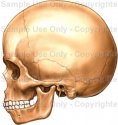The following representation is that of an adult, but it gives a good idea of just how intricately the facial bone structure works together, being held in place by the integumentary ( skin ) structure. On a smaller mandible/maxxila, depending on if the duct tape is the standard 2 inches or 3, both airways would easily be covered with layered tape. Without the tape clinging to the remaining hair, it could not have held in place. I also
speculate that perhaps the clumps of hair matted beneath the skull, might have done so from body fluids & being in a dependent position.
http://ebsco.smartimagebase.com/generateexhibit.php?ID=3535
The facial skeleton serves to protect the brain; house and protect the sense organs of smell, sight, and taste; and provide a frame on which the soft tissues of the face can act to facilitate eating, facial expression, breathing, and speech. The primary bones of the face are the mandible, maxilla, frontal bone, nasal bones, and zygoma (see Image 1). Facial bone anatomy is complex yet elegant in its suitability to serve a multitude of functions.
Mandible
The mandible is a U-shaped bone (see Images 2-3). It is the only mobile bone of the facial skeleton, and, since it houses the lower teeth, its motion is essential for mastication. It is formed by intramembranous ossification. The mandible is composed of 2 hemimandibles joined at the midline by a vertical symphysis. The hemimandibles fuse to form a single bone by age 2 years. Each hemimandible is composed of a horizontal body with a posterior vertical extension termed the ramus.
http://emedicine.medscape.com/article/835401-overview





